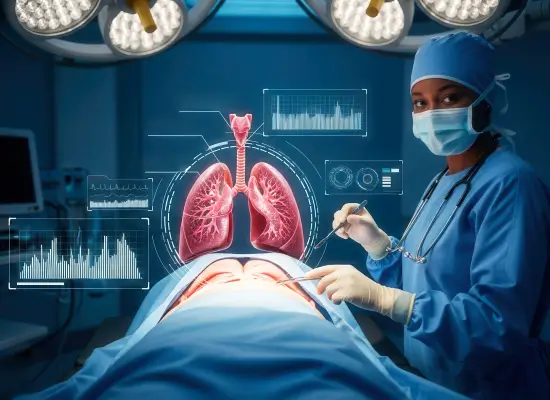VATS lung surgery is a minimally invasive procedure that is performed to treat complex lung conditions, primarily lung cancer.

Synopsis
VATS lung surgery is a minimally invasive surgical procedure used to diagnose and treat ailments in the chest. This procedure is primarily performed on patients with lung cancer, but it can also be applied to other thoracic conditions, including oesophageal cancer and pleural effusion.
VATS lung surgery is generally a minimally invasive technique that can help reduce pain, shorten recovery time, and improve overall outcomes. Choose Gleneagles Hospitals to ensure the best results for your VATS lung surgery, with expert care, advanced technology, and personalised treatment plans tailored to every patient.
Introduction
VATS lung surgery is becoming an increasingly common procedure for treating complex lung conditions. This technique is also used for procedures in the heart, oesophagus, thymus, pleural, or pericardium. It has significantly fewer risks compared to conventional open-chest surgery and can improve the quality of life for patients. VATS requires specialised training and clinical experience to achieve maximum benefits. Choose Gleneagles Hospitals to ensure the best outcome for your VATS lung surgery.
What is VATS Lung Surgery?
In a VATS lung surgery, your thoracic or cardiothoracic surgeon inserts a tiny tube with a video camera at the end, called a thoracoscope, through the small incision in your chest. This helps your surgeon see clearly inside the chest cavity. Your surgeon will then insert specialised surgical instruments into separate small incisions and perform the procedure with the help of the thoracoscope.
VATS surgery is typically used to diagnose and treat lung cancer or metastatic cancer that has spread to the lungs. Since the procedure is minimally invasive, it reduces surgical trauma, has less visible scarring, and a faster recovery period.
Types of VATS Lung Surgery
Video-assisted thoracic surgery (VATS) is a popular, minimally invasive method to treat complex lung conditions. Here are some common types of VATS lung surgery:
- VATS Lobectomy: Removes a lobe or a large section of the lungs. It is typically reserved to treat lung cancer.
- VATS Wedge Resection: Removes the small wedge-shaped pieces of the lung tissue that are used to diagnose nodules or treat early-stage lung cancer.
- VATS Bullectomy: Removes the air-filled spaces (bullae) of the lungs, usually used to treat conditions like emphysema.
- VATS Thymectomy: Removes the thymus gland of the lungs. It is mostly used to treat myasthenia gravis or thymoma.
- VATS Biopsy: Removes small amounts of tissue from the patient’s lungs to examine for cancer cell growth.
Your health matters – get expert advice today.
Why Choose VATS Lung Surgery?
VATS lung surgery is a beneficial procedure that treats complex lung conditions with minimally invasive surgeries. It makes small incisions that lead to less pain and scarring, as well as fewer postoperative complications. Here are some common cases where VATS lung surgery offers significant improvements:
- Lung Cancer: VATS can be used to diagnose and treat lung cancers effectively.
- Pneumothorax: This refers to a condition where the lung collapses partially or completely due to an air leak in the space between the lung and the chest wall.
- Pleural Infection: A bacterial infection in the pleural space that can lead to serious complications and even death.
- Pulmonary Nodule: Small and abnormal growths in the lungs that are typically asymptomatic.
- Empyema Thoracis: A condition where pus collects in the pleural space, usually due to bacterial infection.
- Pleural Effusion: A buildup of fluid in the space between the lung and the chest wall.
Preparation for VATS Lung Surgery
Proper preparation for VATS lung surgery has many steps. One must be aware of how to prepare for a smooth procedure and successful outcomes.
Preoperative Evaluation: Your doctor will review your overall health and conduct a physical examination to assess your condition. Imaging tests are usually recommended to evaluate the condition of the lungs. Other diagnostic tests like pulmonary function tests, blood tests, ECG, and bronchoscopy are conducted to see whether you are fit to undergo the surgery.
Lifestyle Adjustments:
- Quit smoking for at least 2–4 weeks before the surgery to improve healing.
- Eat a healthy and balanced diet to support recovery.
- Engage in light physical exercises to maintain lung function.
- Limit alcohol intake to avoid complications.
Medication Adjustments:
- You will be asked to stop taking blood thinners.
- Diabetes medication will be adjusted if necessary.
Hospital Preparation:
- Avoid food or drink for at least 6–8 hours before the surgery.
- Pack essentials like loose clothing, personal hygiene items, ID, and documentation.
Mental Preparation: Prepare your questions and discuss any concerns with your surgeon to relieve anxiety and set realistic expectations. Seek support if you feel distressed about the procedure.

VATS Lung Surgery Procedure
- Anesthesia & Patient Preparation: The patient is put under general anaesthesia. A breathing tube is inserted for lung ventilation. The patient is positioned on their side with the affected lung facing upward. The operating area is sterilised, and monitoring equipment is set up.
- Incision & Camera Insertion: The surgeon makes 2–4 small incisions of 3–4 cm each between the ribs. A thoracoscope (tiny camera) is inserted through one incision to get a clear, magnified view of the chest.
- Surgical Procedure: Depending on the patient’s condition, procedures like lobectomy, wedge resection, bullectomy, or pleural procedures are carried out using specialised instruments.
- Closure: The surgeon closes the small incisions with sutures or staples.
Recovery and Aftercare
At Gleneagles Hospital, you will be administered complete pain management to help with the discomfort after VATS lung surgery. The chest tube remains in place for 1–3 days to drain fluid and excess air. Breathing exercises and early mobilisation are encouraged.
You will need to keep the area of the incision clean. Always look out for signs of infection around the incision area. Avoid heavy lifting for a few weeks. Lifestyle changes like quitting smoking and alcohol go a long way in improving lung function.
Risks & Complications after VATS Lung Surgery
There are a few risks and complications involved:
- Air Leak: Air continues to leak from the lung even after surgery.
- Bleeding: Can happen during and after surgery.
- Infection: Wound or lung infections can occur.
- Nerve Damage: Potential risk of nearby nerve injury.
- Arrhythmias: Abnormal heart rhythm during or after surgery.
- Blood Clots: Clots may form in the legs or lungs after surgery.
Why Choose Gleneagles Hospital for VATS Lung Surgery?
Gleneagles Hospitals is a top name for VATS lung surgery. It has seen great success with the help of expert specialists and a patient-centric approach.
- Expert Surgeons: Highly skilled and experienced with VATS surgery.
- State-of-the-Art Facilities: Equipped to meet the needs of VATS patients.
- Minimally Invasive Techniques: Less downtime and faster recovery.
- World-Class Infrastructure: Modern operating rooms and recovery facilities.
- High Success Rate: Exceptional results in a short period.
Frequently Asked Questions
VATS lung surgery has fewer risks, less postoperative trauma, and a shorter recovery period compared to open-chest surgery.
It is commonly used to treat lung cancer, pleural effusions, and to perform biopsies of lung tissues.
Patients usually need 4–8 weeks to recover and return to normal activities.

















